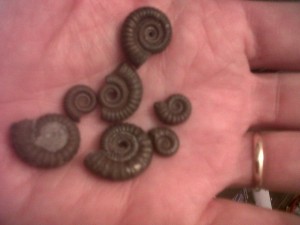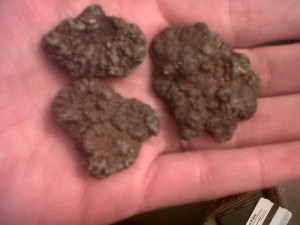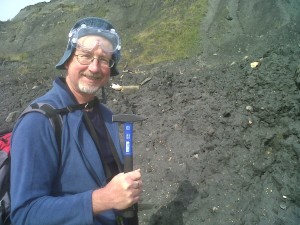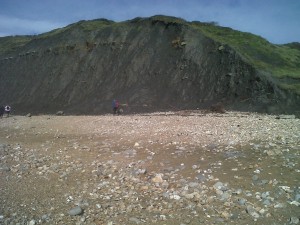 Pyritic ammonites – I found the first one by accident. We were at Charmouth on the Jurassic Coast. We’d just had lunch at the Heritage Centre Café and crossed the bridge heading up the beach toward Golden Cap. The mountain of mud rose up above us on our left and the sea on our right. Raymond, in his goggles, with hammer in hand was ready to find the pterodactyl we were sure we’d find.
Pyritic ammonites – I found the first one by accident. We were at Charmouth on the Jurassic Coast. We’d just had lunch at the Heritage Centre Café and crossed the bridge heading up the beach toward Golden Cap. The mountain of mud rose up above us on our left and the sea on our right. Raymond, in his goggles, with hammer in hand was ready to find the pterodactyl we were sure we’d find.
Instead, I found a tiny pyritic ammonite. At first I thought someone had lost a charm off an earring or a bracelet. The ammonite was shiny and metallic, but it was a fossil, no bigger than a five pence piece, and perfectly formed. Pyritic ammonites, Raymond told me, were formed when the shells of the ammonites were gradually replaced in the fossilization process with iron pyrite.
A very helpful gentleman walking his dog on the beech told us that we needed to look for
the black places in the sand. That’s where the mud had washed down with the last tide or last night’s rain. Raymond put the hammer away, took off the goggles and the ammonite hunt was on.Lesson number one: Look for the black wash-outs in the sand. That’s where the mud has washed out from the Jurassic mud mountain.
Lesson number two: Look for the dino-poo. Okay, it’s probably really ichthyo-poo, but you get the picture. We discovered that once we found the mud wash-outs, then the best places to look for the pyritic ammonites were the places where we found coprolites. Yep, that’s right, fossilized poo – which was also pyritic.
 Why on earth am I telling you about dino-poo, you may wonder. Well because of the way the pieces fit together. You know, the pieces of any puzzle, what has to happen in order to see the whole picture. First we looked for the dark spots in the sand, then we looked for the fossilized poo. Then we found those exquisite, pendant perfect pyritic ammonites.
Why on earth am I telling you about dino-poo, you may wonder. Well because of the way the pieces fit together. You know, the pieces of any puzzle, what has to happen in order to see the whole picture. First we looked for the dark spots in the sand, then we looked for the fossilized poo. Then we found those exquisite, pendant perfect pyritic ammonites.
Somehow our eyes got used to finding the mud then the poo then pulling back just enough to see the delicate curved edges sparkling in the sand. It was sort of like playing the slot machines in Vegas, just one win could keep you going for ages. Just one little ammonite could totally focus our attention for however long it took until we found the next one lying round and perfect and bright amid the coprolites. And then we were off to look for the next one until the tide came in and we had to retreat, always shaking our heads, always thinking about all those loveley ammonites washing out to sea.
They were all tiny – every pyritic ammonite we found. A low-tide beach combing would net us less than a palm full and yet they were exquisite, perfectly formed, looking like they’d come from a jewelry store rather than just washed out of the mud with the fossilized poo.
I can’t stop thinking about it, treasure in strange places. Not just treasure, but ancient treasure, and we carried them back to our cottage in the palm of our hand, feeling the weight of them pressed like coins in a child’s clenched fist. Our week in Lyme Regis was amazing. There were so many good things; laughter and friend and writing and fish pie and good ale in local pubs, but it’s the pyritic ammonites I’ll remember most, and the delightful treasure hunt of finding them.
Oh Im so envious I love fossil hunting, what a great day out and I wish we lived near this place, thats so special to find your very own fossils and be the first person in thousands of years to touch it wow!
I will be looking for dino poo too now you made me laugh outloud lol.
Great post thanks for sharing and I loved the piks.
Hugs
XxX
Thanks Midnight,
It was a new experience for me, and I loved it. It was especially nice since Raymond has taken the fossil course through the Open Uni, so I had an expert with me. Very glad you enjoyed the post.
Kx
OK, the title of this blog post wins “best email title in my morning inbox” for sure!
Lol, Shar!
I wasn’t sure if I was being too naughty with the title, but it just had to be. Who know dino-poo could be so fascinating?
Kx